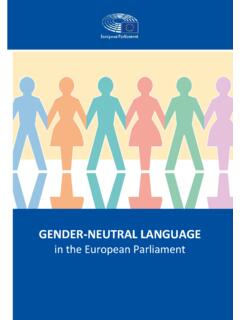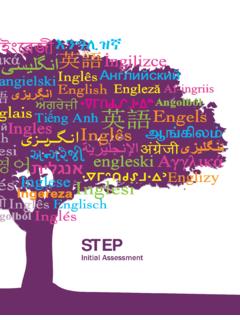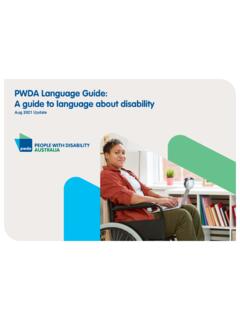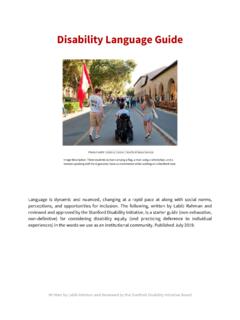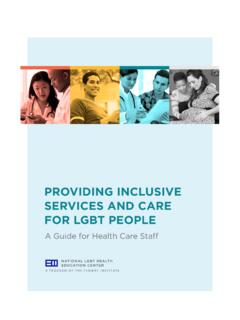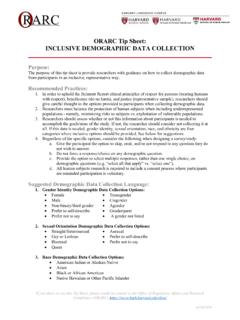Transcription of A guide to preventing and addressing social stigma
1 social stigma associated with COVID-19. A guide to preventing and addressing social stigma1. Target audience: Government, media and local organisations working on the new coronavirus disease (COVID-19). WHAT IS social stigma ? social stigma in the context of health is the negative association between a person or group of people who share certain characteristics and a specific disease. In an outbreak, this may mean people are labelled, stereotyped, discriminated against, treated separately, and/or experience loss of status because of a perceived link with a disease. Such treatment can negatively affect those with the disease, as well as their caregivers, family, friends and communities. People who don't have the disease but share other characteristics with this group may also suffer from stigma . The current COVID-19 outbreak has provoked social stigma and discriminatory behaviours against people of certain ethnic backgrounds as well as anyone perceived to have been in contact with the virus.
2 WHY IS COVID-19 CAUSING SO MUCH stigma ? The level of stigma associated with COVID-19 is based on three main factors: 1) it is a disease that's new and for which there are still many unknowns; 2) we are often afraid of the unknown; and 3) it is easy to associate that fear with others'. It is understandable that there is confusion, anxiety, and fear among the public. Unfortunately, these factors are also fueling harmful stereotypes. WHAT IS THE IMPACT? stigma can undermine social cohesion and prompt possible social isolation of groups, which might contribute to a situation where the virus is more, not less, likely to spread. This can result in more severe health problems and difficulties controlling a disease outbreak. stigma can: Drive people to hide the illness to avoid discrimination Prevent people from seeking health care immediately Discourage them from adopting healthy behaviours 1 This checklist includes recommendations from Johns Hopkins Center for Communication Programs, READY Network.
3 1. Updated 24 February 2020. HOW TO ADDRESS social stigma . Evidence clearly shows that stigma and fear around communicable diseases hamper the response. What works is building trust in reliable health services and advice, showing empathy with those affected, understanding the disease itself, and adopting effective, practical measures so people can help keep themselves and their loved ones safe. How we communicate about COVID-19 is critical in supporting people to take effective action to help combat the disease and to avoid fuelling fear and stigma . An environment needs to be created in which the disease and its impact can be discussed and addressed openly, honestly and effectively. Here are some tips on how to address and avoid compounding, social stigma : 1. Words matter: dos and don'ts when talking about the new coronavirus (COVID-19). 2. Do your part: simple ideas to drive stigma away 3.
4 Communication tips and messages. WORDS MATTER: When talking about coronavirus disease, certain words ( suspect case, isolation ) and language may have a negative meaning for people and fuel stigmatizing attitudes. They can perpetuate existing negative stereotypes or assumptions, strengthen false associations between the disease and other factors, create widespread fear, or dehumanise those who have the disease. This can drive people away from getting screened, tested and quarantined. We recommend a people- first' language that respects and empowers people in all communication channels, including the media. Words used in media are especially important, because these will shape the popular language and communication on the new coronavirus (COVID-19). Negative reporting has the potential to influence how people suspected to have the new coronavirus (COVID-19), patients and their families and affected communities are perceived and treated.
5 There are many concrete examples of how the use of inclusive language and less stigmatizing terminology can help to in control epidemics and pandemics from the HIV, TB and H1N1 DOS and DON'TS. Below are some dos and don'ts on language when talking about the new coronavirus disease (COVID-19): DO - talk about the new coronavirus disease (COVID-19). Don't - attach locations or ethnicity to the disease, this is not a Wuhan Virus , Chinese Virus or Asian Virus . The official name for the disease was deliberately chosen to avoid stigmatisation - the co stands for Corona, vi for virus and d for disease, 19 is because the disease emerged in 2019. 2 UNAIDS terminology guidelines: from AIDS victim' to people living with HIV'; from fight against AIDS' to response to AIDS'. 2. Updated 24 February 2020. DO - talk about people who have COVID-19 , people who are being treated for COVID-19 , people who are recovering from COVID-19 or people who died after contracting COVID- 19.
6 Don't - refer to people with the disease as COVID-19 cases or victims . DO - talk about people who may have COVID-19 or people who are presumptive for COVID-19 . Don't - talk about COVID-19 suspects or suspected cases . DO - talk about people acquiring or contracting COVID-19. Don't talk about people transmitting COVID-19 infecting others or spreading the virus as it implies intentional transmission and assigns blame. Using criminalising or dehumanising terminology creates the impression that those with the disease have somehow done something wrong or are less human than the rest of us, feeding stigma , undermining empathy, and potentially fuelling wider reluctance to seek treatment or attend screening, testing and quarantine. DO - speak accurately about the risk from COVID-19, based on scientific data and latest official health advice. Don't - repeat or share unconfirmed rumours, and avoid using hyperbolic language designed to generate fear like plague , apocalypse etc.
7 DO - talk positively and emphasise the effectiveness of prevention and treatment measures. For most people this is a disease they can overcome. There are simple steps we can all take to keep ourselves, our loved ones and the most vulnerable safe. Don't - emphasise or dwell on the negative, or messages of threat. We need to work together to help keep those who are most vulnerable safe. DO - emphasise the effectiveness of adopting protective measures to prevent acquiring the new coronavirus, as well as early screening, testing and treatment. DO YOUR PART: Governments, citizens, media, key influencers and communities have an important role to play in preventing and stopping stigma surrounding people from China and Asia in general. We all need to be intentional and thoughtful when communicating on social media and other communication platforms, showing supportive behaviors around the new coronavirus disease (COVID-19).
8 Here are some examples and tips on possible actions to counter stigmatizing attitudes: Spreading the facts: stigma can be heightened by insufficient knowledge about how the new coronavirus disease (COVID-19) is transmitted and treated, and how to prevent infection. In response, prioritise the collection, consolidation and dissemination of accurate country- and community-specific information about affected areas, individual and group vulnerability to COVID- 19, treatment options and where to access health care and information. Use simple language and 3. Updated 24 February 2020. avoid clinical terms. social media is useful for reaching a large number of people with health information at relatively low Engaging social influencers 4 such as religious leaders on prompting reflection about people who are stigmatized and how to support them, or respected celebrities to amplify messages that reduce stigma .
9 The information should be well targeted and the celebrities who are asked to communicate this information must be personally engaged, and geographically and culturally appropriate to the audiences they seek to influence. An example would be a mayor (or another key influencer) going live on social media and shaking hands with the leader of the Chinese community. Amplify the voices, stories and images of local people who have experienced the new coronavirus (COVID-19) and have recovered or who have supported a loved one through recovery to emphasise that most people do recover from COVID-19. Also, implementing a hero campaign honouring caretakers and healthcare workers who may be stigmatized. Community volunteers also play a great role in reducing stigma in communities. Make sure you portray different ethnic groups. All materials should show diverse communities being impacted and working together to prevent the spread of COVID-19.
10 Ensure that typeface, symbols and formats are neutral and don't suggest any particular group. Ethical journalism: Journalistic reporting which overly focuses on individual behaviour and patients'. responsibility for having and spreading COVID-19 can increase stigma of people who may have the disease. Some media outlets have, for example, focused on speculating on the source of COVID-19, trying to identify patient zero in each country. Emphasizing efforts to find a vaccine and treatment can increase fear and give the impression that we are powerless to halt infections now. Instead, promote content around basic infection prevention practices, symptoms of COVID-19 and when to seek health care. Link up: There are a number of initiatives to address stigma and stereotyping. It is key to link up to these activities to create a movement and a positive environment that shows care and empathy for all.










